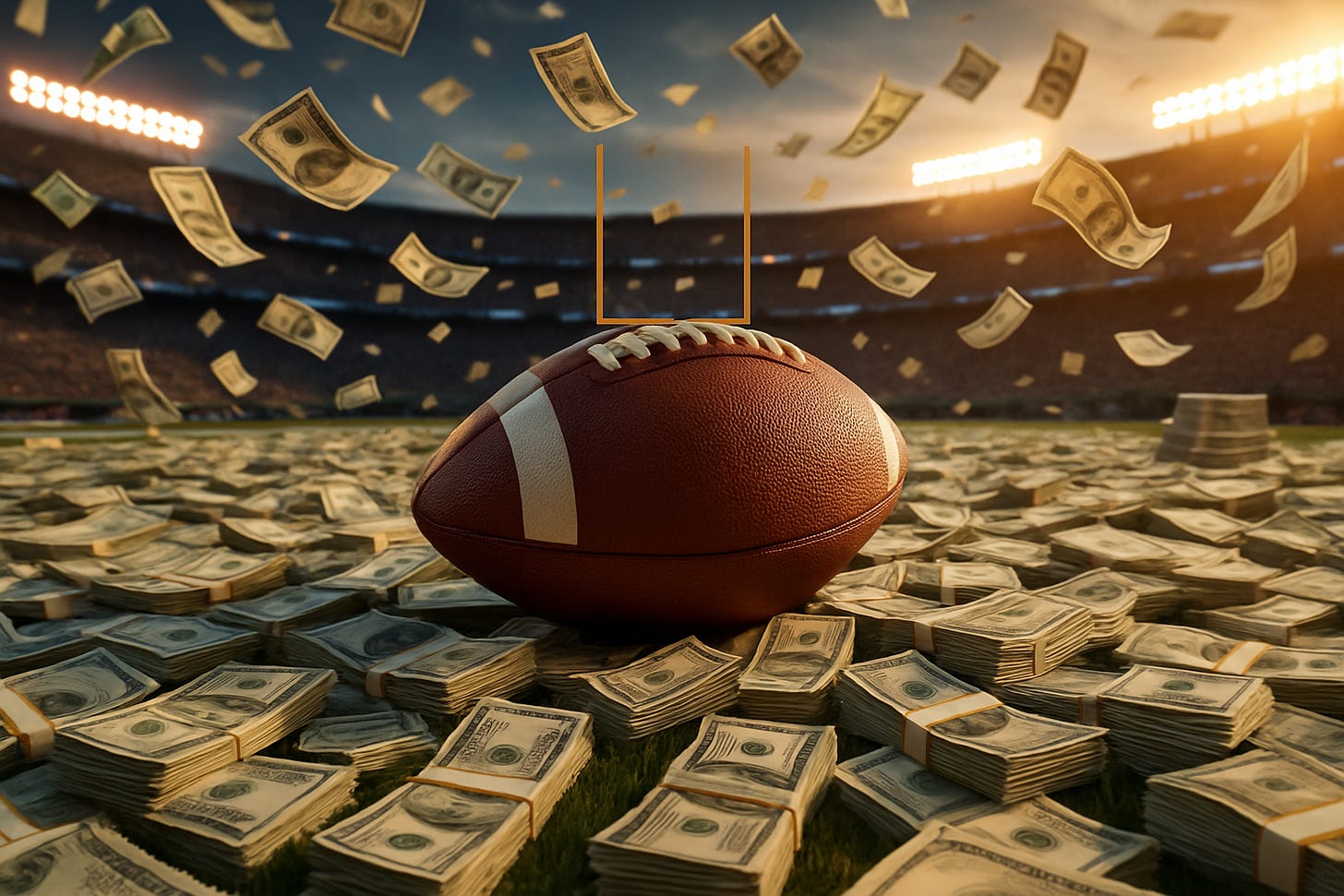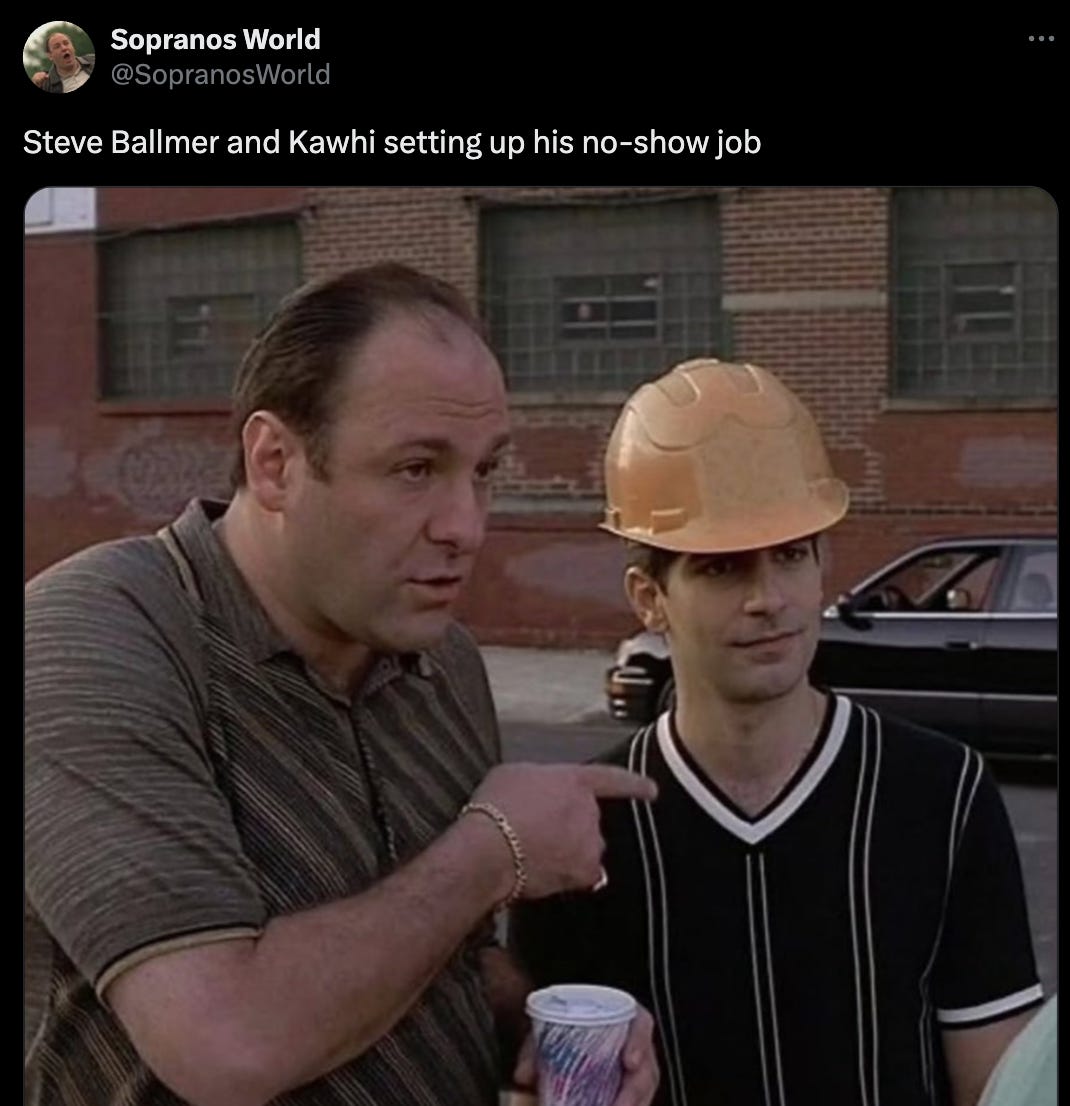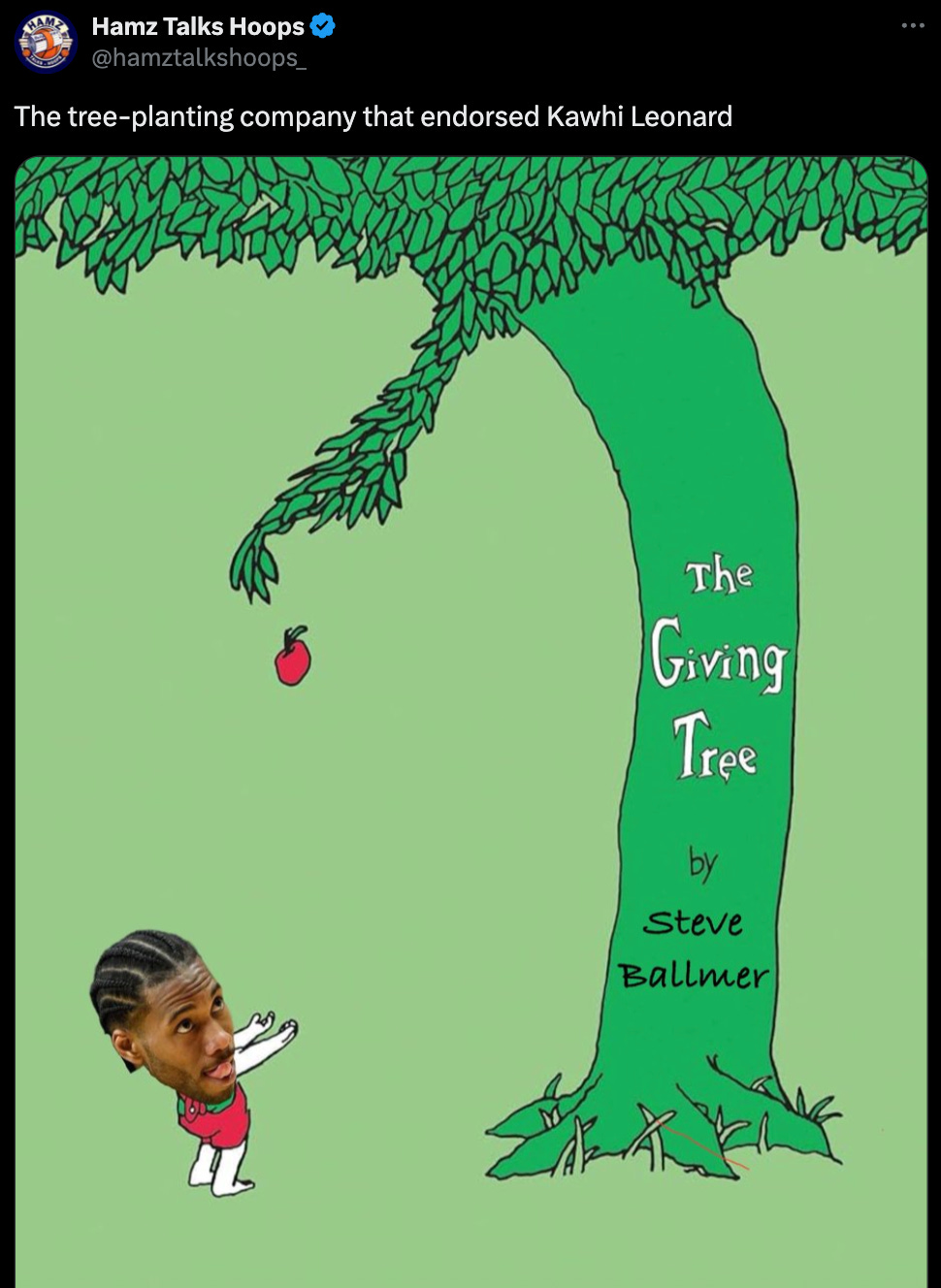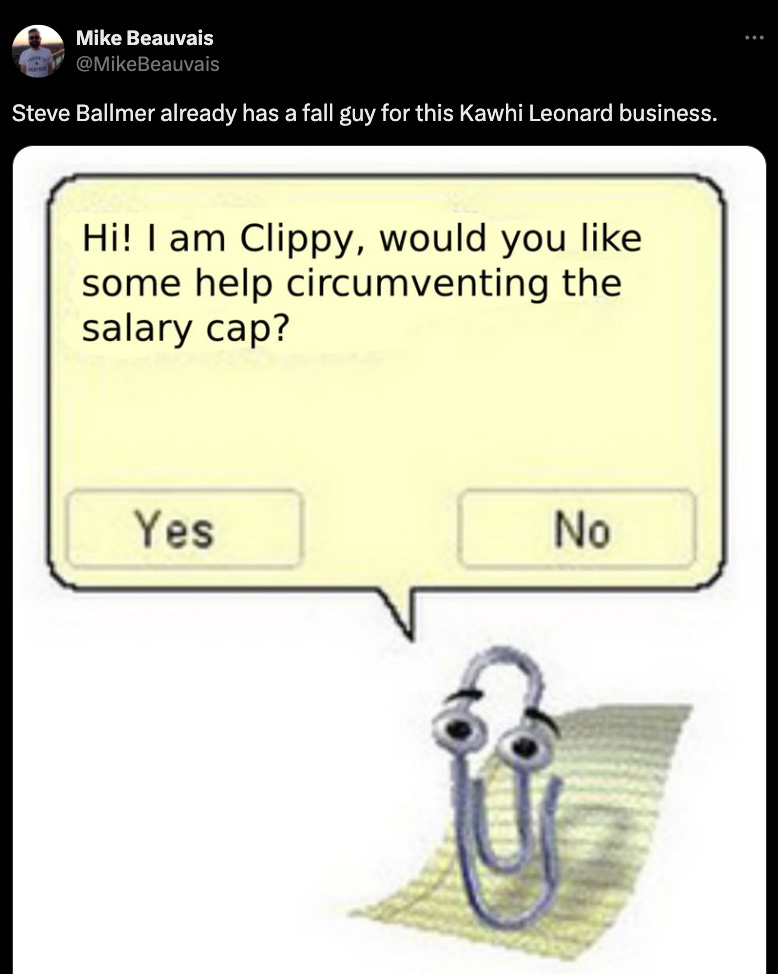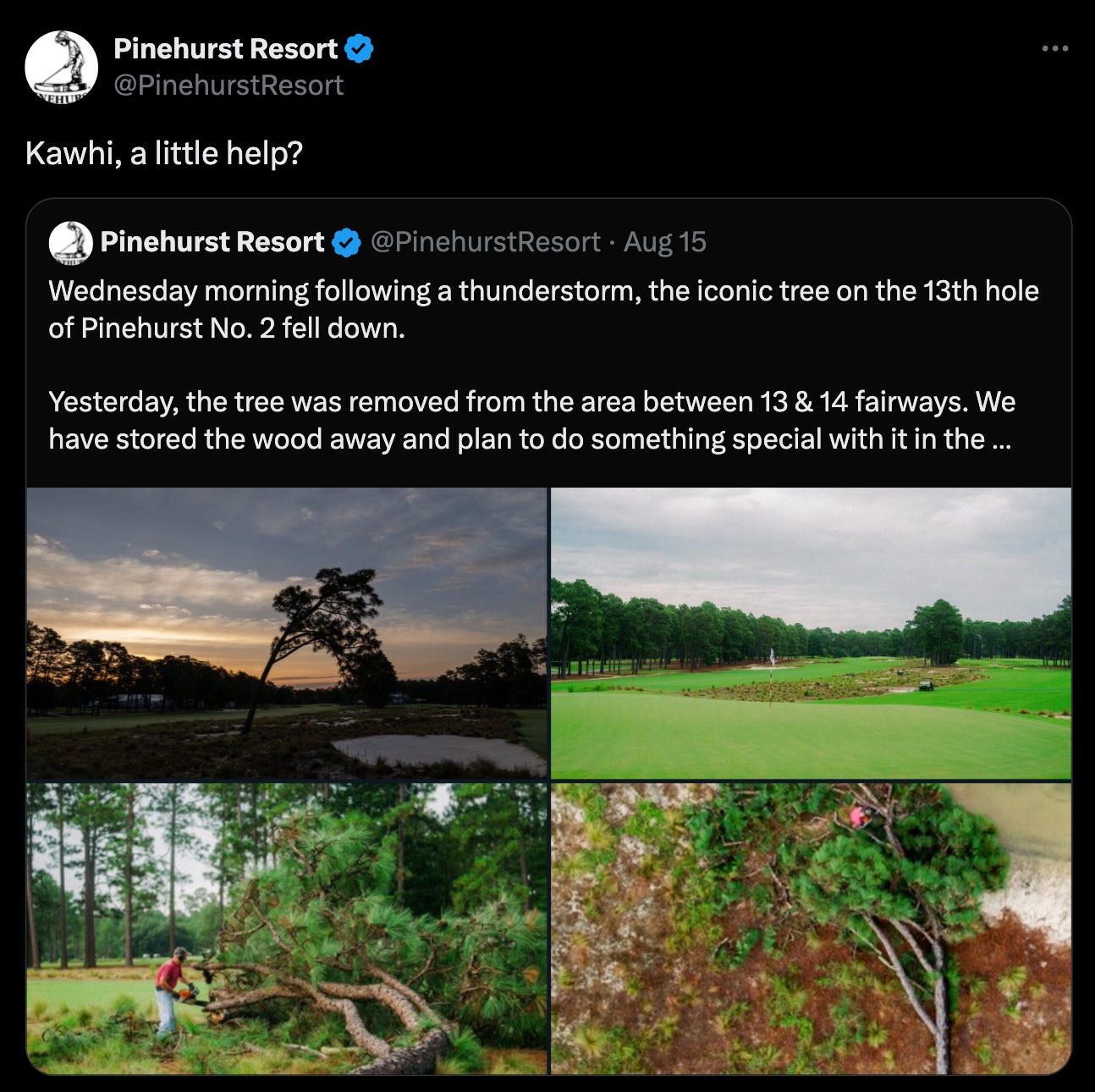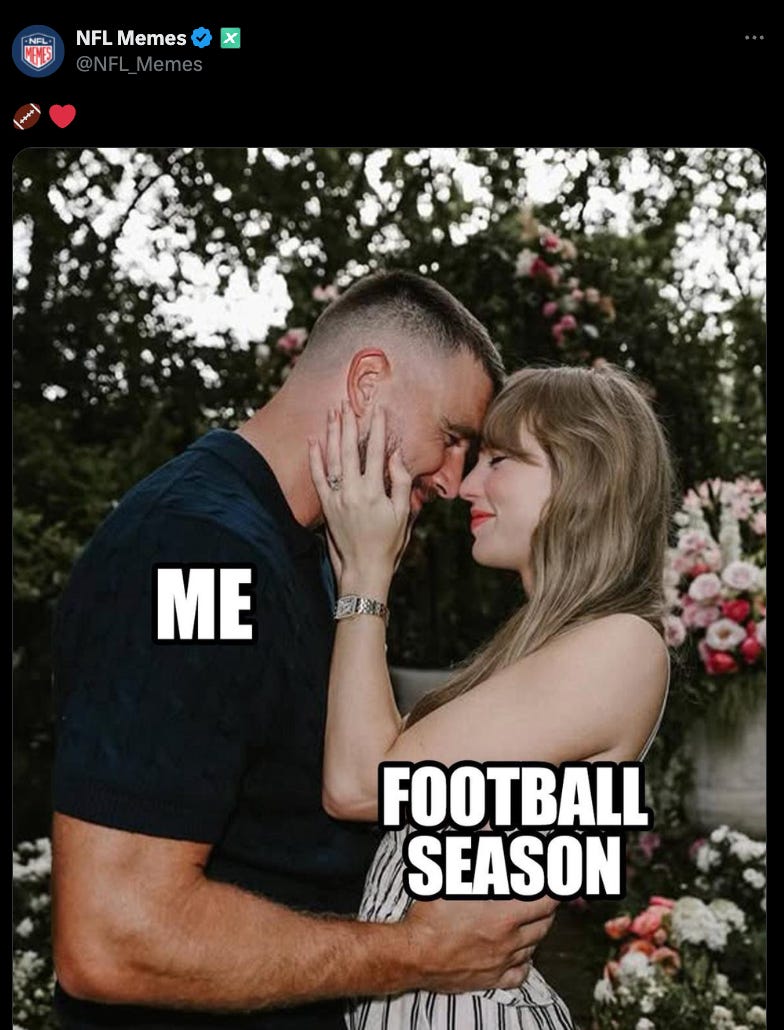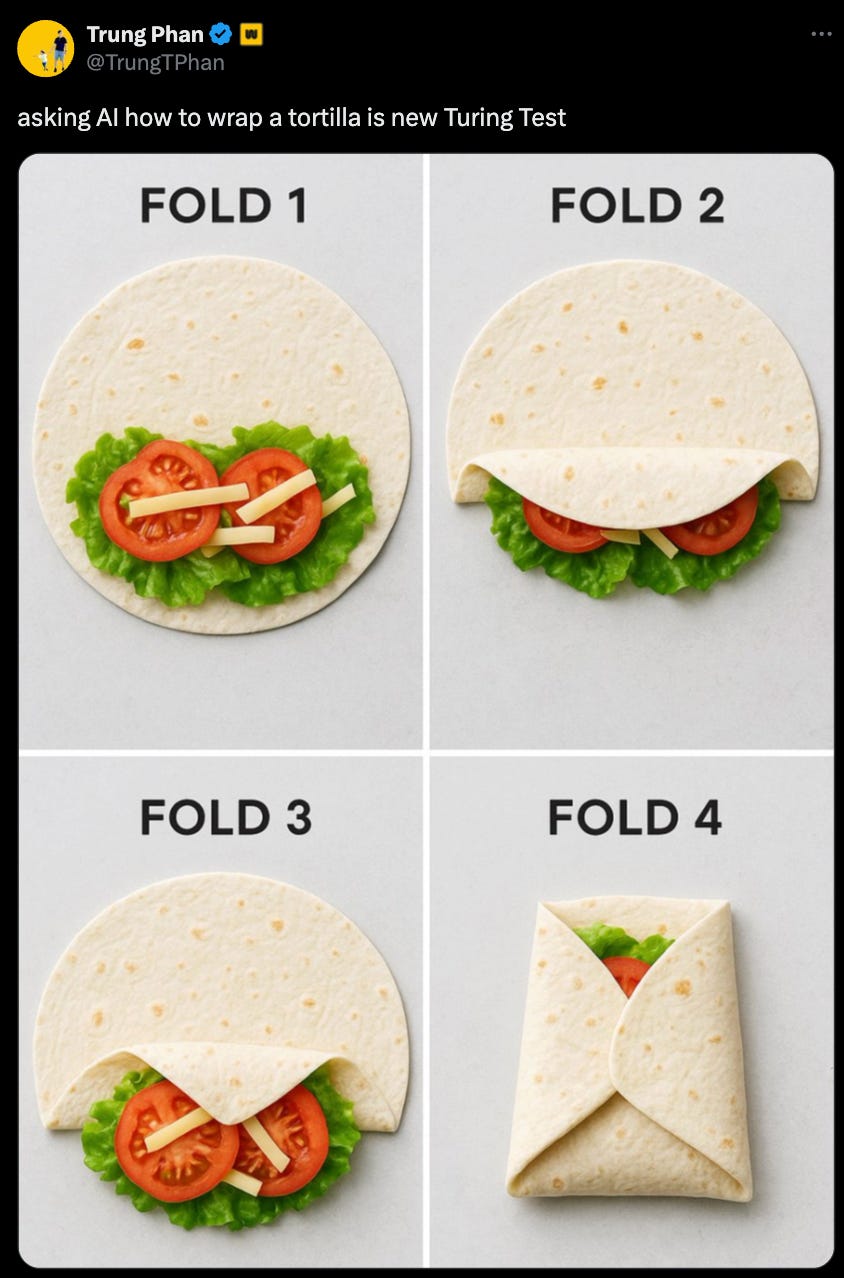America’s $37B Football Obsession
The top two sports-leagues by revenue in the world are NFL ($23B)...and College Football ($14B), the latter alone makes more than NBA, MLB or English Premiere League.
Thanks for subscribing to SatPost.
Today, we will talk about:
America’s $37B Football Obsession
Google Isn’t Getting Broken Up
A Wild NBA Scandal (Involving Steve Ballmer)
…and them fire posts (including a new Turing Test)
America’s $37B Football Obsession
I know a lot of you readers will be getting your NFL on this weekend because the league is an absolute beast:
Revenue hit $23B in 2024 (top among all sports leagues)
It has the highest average sports franchise value at $7B (vs. NBA at $4B, MLB at $3B, English Premier League at $2B and my pick-up basketball league of whoever is at the court on Saturday around 10am at $0).
Over 90 of the 100 most-watched TV broadcasts in America are NFL games
30 million people play NFL fantasy football and a projected $30B will be bet on the sport in 2025
American football is just the perfect media asset in the age of the internet.
There are only 17 weekly regular-season games for each team. So, every game is scarce and it’s a shared event because everyone knows everyone else is watching. Relative to other leagues, it’s a smaller time commitment and the individual games are higher stakes (I’m looking at you, MLB). The game is very strategic as countless Madden fiends will know. Since the game is snap-by-snap, there is a lot of time for replays and color commentary to explain the plays and suck people further into the lore.
The NFL’s multi-decade popularity has survived major recent scandals including CTE, domestic violence and the blackballing of Colin Kaepernick.
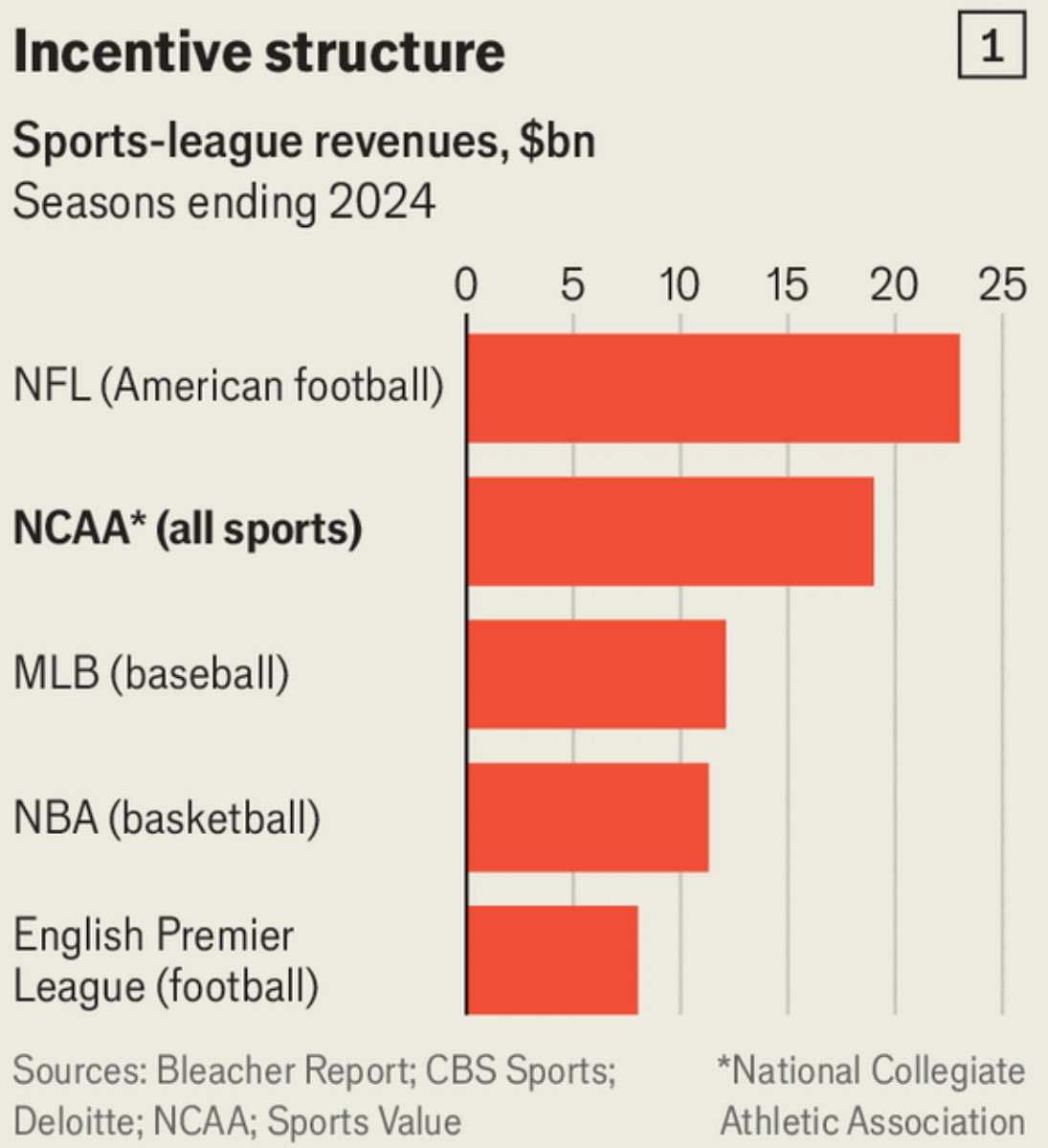
Admittedly, I haven’t spent as much time with the NFL in recent years. But I will always be grateful to LaDainian Tomlinson for carrying my 2006 fantasy team and usually lock in whenever the playoffs roll around (especially this year because I will be laying down multiple Taylor Swift-related prop bets in the lead up to the Super Bowl).
Either way, the NFL’s ability to monetize scarce attention is unparalleled.
Writer Derek Thompson brought up a great point earlier in the year regarding the dichotomy between how people watch the NFL and NBA:
This week [that Luka Doncic was traded to the LA Lakers] was a wildly extreme example of a trend I'm obsessed with in sports media.
I have consumed, conservatively, 10 hours of NBA podcast gossip this week (80% Luka analysis/conspiracies). Meanwhile, I genuinely don't think I've watched ten consecutive minutes of NBA on TV since the Finals.
On the other hand, I have consumed maybe 15 mins of Super Bowl media content this week (rare case, to be clear; I subscribe to 4 or 5 NFL pods I adore, but my appetite for Luka gossip, plus the rematch nature of the KC-Philly SB, temporarily squeezed them out). Meanwhile, I'll watch every minute of the Super Bowl from the national anthem to the confetti drop.
On that note, the opening week of the NFL happened to coincide with maybe one of the largest NBA scandals in recent decades (I write more on this later in the newsletter).
So yeah, a lot of the NBA Cinematic Universe (social media drama, podcasts, individual star brands) is off the court and isn’t monetized that well by the NBA. Conversely, the NFL product is milked to the highest degree with multiple game packages sold to the highest bidders with massive audiences (Sunday, Sunday Night, Monday Night, Thursday Night etc.).
Even though the NFL is not very popular outside of North America — while basketball is the second-most popular sport in the world (after soccer…sorry, real football) — the comparison with the NBA suggests there is even more revenue to be squeezed.
Beginning in 2025, the NBA’s newly signed rights deal is valued at $77B over 11 years. That’s a 2.5x increase compared the NBA’s previous deal and stacks up relatively well to the $111B over 11 years that the NFL signed for in 2021.
Based on their cultural cachet, the NBA at $7B a year suggests that the NFL should be making a lot more than $10B a year on the media rights side.
Clearly, NBA commissioner Adam Silver is a very strong negotiator.
The win for the NBA will end up being a win for the NFL because a new floor has been set.
NFL Commissioner Roger Goodell took on the role in 2006. In 2010, he predicted that the NFL would hit revenue of $25B by 2025. He basically called his shot and looks to be positioning the league for its next deal that could be $15-20B a year just on media rights.
He’s doing this even as the cable TV industry — which the NFL is almost entirely propping up — continues to wither.
One reason is that the league has all its digital chips in place. The upcoming season is the first one in NFL history when every game is offered over-the-top. This is driven by the launch of the new-and-improved ESPN and Fox One streaming apps.
In fact, the NFL recently struck a deal with “The Worldwide Leader In Sports” to further strengthen its hand: it took a 10% stake in ESPN in exchange for giving the ABC-owned sports network top-tier NFL media assets including cable (NFL Network, NFL RedZone) and digital (NFL Fantasy).
By beefing up ESPN and its parent Disney, the NFL ensures there’s a strong legacy bidder for its media rights. With cable TV players getting clapped, the NFL doesn’t want Big Tech — Amazon already has Thursday Night and YouTube has NFL Sunday Ticket (and Netflix did the Christmas Games)— to be the only people bidding.
***
The NFL isn’t the only football money machine in America.
American Football is also a beast at the US college sports level (US College Game Day dominates on Saturday while NFL obviously goes hard AF on Sunday).
Sports-league revenue for NCAA reached $19B in 2024, which is more than any global sport league besides the NFL. College football makes up 3/4 of that figure (the remaining 1/4 is for men’s basketball), which works out to ~$14B and is more than either the MLB or NBA (~$13B each).
Before Europeans yell at me, the combined revenue for top five European football leagues is ~$21.5B:
English Premier League: $8B
La Liga in Spain: $4.5B
Bundesliga in Germany: $4B
Series A in Italy: $3B
Ligue 1 in France: $2B
But each individually is smaller than aforementioned American leagues and the total value is still less than the NFL.
Combined, the NFL and College Football did $37B of revenue in 2024.
For comparison’s sake, $37B is more revenue than everyone’s favourite maker of semiconductor machines (ASML, $35.4B), Spiced Pumpkin Lattes (Starbucks, $36.6B) and interest-rate rigging scandals (Barclays, $36.6B).
I actually don’t know if that’s too low based on football’s mindshare in America.
I’ll leave it for you to decide by listing a random mix of companies with higher revenue including Salesforce ($39B), Visa ($39B), Nike ($46B) and Coca-Cola ($47B).
The football revenue is in the ballpark with the world’s largest media players: Warner Bros. Discovery ($39B), Netflix ($42B), YouTube ads and subscriptions (~$50B) or Disney ex-theme parks and cruises (~$60B).
Something to noodle on.
Back to the lucrative business of college sports. These operations just warps the entire post-secondary academic enterprise. Here are some wild stats, per The Economist:
in 43 of 50 states, the highest paid public employee is a college football or basketball coach
60% of “athletic department spending fell into just three categories: facilities, coaching salaries and pay for athletic department staff” and “barely 10% went to scholarships”
70% of top-tier sporting public universities use academic funds to prop up the athletic program (!!!!!!!!!!)
over the past 20 years, “athletic-department spending has grown by 244%, compared with a 113% rise in academic spending”
As with most sports leagues, college sports make money from media rights, ticketing, sponsorship and merch.
There are two notable differences, though.
First, college sports operates as non-profits. Not only does it shield the NCAA and major college leagues from certain taxes, but its partners can deduct fees paid from their own taxes as explained by The Washington Post:
The NCAA isn’t the only organization that benefits from its tax status. Because broadcast networks can deduct the rights fees they pay to the NCAA from their taxes as a cost of doing business — just as a manufacturer can deduct the cost of raw materials — the income is fully outside of the tax system, making it what economists call double nontax income.
In 2024, NCAA revenue from broadcast rights totaled more than $948 million. According to the organization’s financial statements, 2025 marks the first year of an $8.375 billion broadcast and marketing rights contract with CBS that extends through 2032. This is also the first year of an eight-year, $920 million contract with ESPN. The NCAA’s annual March Madness basketball tournament is so popular that the championship game routinely draws more TV viewers than any game of the NBA Finals.
The NCAA is just the tip of the tax-exempt sports economy. In 2022, tax returns of the then-Power Five collegiate athletic conferences — the ACC, Big 12, Big Ten, Pac-12 and SEC — show that they generated more than $3.5 billion in combined revenue, including $2.5 billion in television rights. The College Football Playoff — which is a limited liability corporation managed by the 10 Football Bowl Subdivision conferences and the University of Notre Dame — generates another $1.3 billion annually.
In form and function, these organizations are no different than the major professional sports leagues in that they collect broadcast rights and redistribute much of that revenue to their members, who in this case are university athletic departments.
Second, the schools never paid the student athletes…until now.
After being eligible to monetize their Name, Image and Likeness (NIL) in 2021 — Arch Manning currently tops the NIL list at ~$7m — this year will be the first time schools will pay student athletes. Each school will have a $20.5m salary cap.
The allowance of salaries came after a class action lawsuit against the NCAA from former student athletes. Over the next decade, the NCAA will pay $2.8B to eligible college players who had played any time since 2016 (the payout is 75% for football, 15% men’s basketball, 5% women’s basketball, 5% remainder).
Without the free players, schools will really have to figure out the balance between academic and athletic budgeting. Their non-profit status may soon be challenged too.
However that shakes out, America’s overall obsession with football is unlikely to diminish…especially the NFL.
The title of a new book by reporter Ken Belson captures it well: “Every Day Is Sunday” (How Jerry Jones, Robert Kraft, and Roger Goodell Turned the NFL into a Cultural & Economic Juggernaut).
“Roger doesn’t view the other leagues as competition,” an NFL executive is quoted in the book saying of Commissioner Goodell. “He wants to be mentioned with Disney and the Vatican, these massive institutions.”
This issue of SatPost is brought to you by Bearly AI
Is your team or enterprise looking for a custom AI chat tool….
…based on your specific data, UX and business needs?
Try Bearly AI, which is now helping enterprise clients connect to leading LLMs (Claude, ChatGPT, Grok, Gemini) with customizable UXs and full data privacy.
Since my technical co-founder does 99.999999999% of the coding, my contribution to this effort is posting a link for enterprise clients interested in a demo for their own custom AI chat tool.
Google Isn’t Getting Broken Up
The US DOJ filed an antitrust case against Google in 2020.
It eventually found that Google’s search business was an illegal monopoly and finally unveiled remedies on Tuesday including:
Google can no longer sign exclusive distribution deals
No forced sale of Chrome browser or Android mobile OS
Google has to share search and click-through data (a snapshot in time, not ongoing)
Goole may have to syndicate up 40% of its search results to competitors
Google can not sign exclusive distribution deals when it comes to Generative AI
The market reacted the same way I did when I saw the Will Ferrell Chaz cameo in Wedding Crashers: it went buck (Google was up 9% (+$200B+) and Apple was up 4% ($100B+) the next day).
Google has been paying Apple $20B a year to be the default search engine on Safari browser (and has similar deals on third-party Android handsets as well as $500m-ish to Mozilla).
Apple investors shot a load because that high high margin revenue — which is like 1/4th of its operating profit — looks to be safe. It won’t be “exclusive” and there is a 1-year time limit on any deal, but the market seems to believe Apple gonna stay eatin’.
As for Google, its ability to still pay for distribution will be massive in the Generative AI race. Again, it can’t be exclusive, but they can pay and multiple anonymous sources tell me that Google IS A CHEDDAR PRINTING MACHINE ($100B net profit in 2024).
Google’s infinite-money glitch search flywheel is so sick that it wants to pay these deals.
The absolute irony of the situation is that the rise of OpenAI played a major role in Google getting to keep Chrome, Android and the distribution deals. According to U.S. District Judge Amit Mehta, the proliferation of “GenAI changed the course of this case” since it was first filed 5 years ago.
“I’m going to take on Google search” was literally the worst pitch you could have made to a VC in 2020 other than “a desktop-sized device that can do a whole panel of tests based on a single drop of blood” or “I want to make a Fish Sauce-flavoured Energy Drink”.
But tens of billions have been flowing to take on Google’s answer-giving use case since ChatGPT’s launch in November 2022. The court’s 226-page remediation document has 30 pages on the AI market and cites major players on multiple occasions: “OpenAI” (30x), “Perplexity” (24x) and “Anthropic” (6x) but — rather insultingly — no mention of my Bearly AI research app.
Also on the irony front: Judge Mehta acknowledged that it would be unfair to punish a company like Mozilla from the Google distribution funds (Apple can obviously live without the funds but punishing the iPhone maker for a case about Google didn’t seem right to the Judge).
OpenAI may really benefit from the access to search data, but Google dodged a bullet.
Two additional takes from Brian Albrecht (who explains why the remedies look a bit soft, and how the language around the punishments changes the future of tech antitrust) and Matt Stoller (who is very critical with the take that “A Judge Lets Google Get Away with Monopoly”).
A Wild NBA Scandal (Involving Steve Ballmer)
Pablo Torre did a 7-month investigation into a financial transaction by LA Clippers owner (and former Microsoft CEO) Steve Ballmer that is turning the league upside down:
Steve Ballmer is the richest owner in any sport (which is helped by the fact that he’s the 7th richest person in the world at $150B from HODL-ing his ~3% stake in Microsoft).
The NBA has a punitive salary cap and one reason is that other owners — who are rich but not centi-billy rich — are afraid that someone like Big Daddy Ballmer can massively outspend them.
Back in 2019, the NBA investigated the Clippers for trying to circumvent the salary cap (this can be done by cutting side deals with a player or finding other non-salary ways to compensate them); Adam Silver called this the “cardinal sin”.
Torre’s investigation found that star Clippers player Kawhi Leonard was paid $28m over 4 years for a “no show” endorsement job for a green bank called Aspiration, a climate startup that ostensibly sold carbon credits by paying to have people plant trees. (There was one LA Clippers tweet about Aspiration and Kawhi, which is an incredible historical record; I noted it and Pablo quickly fact-checked me).
Aspiration was founded by some Democrat insiders and raised funds that valued their climate startup at $2.3B at one point. Steve Ballmer contributed at least $50m to the startup.
The startup imploded and one of its co-founders has plead guilty for wire fraud (investors lost $248m on the startup, which didn’t actually do what it claimed to do).
Here’s where it gets wild: because Aspiration imploded, its list of creditors became available.
Kawhi Leonard’s endorsement contract was leaked and it basically guaranteed him $7m a year for 4 years with zero real obligations and he would only get paid if he was still with the Clippers (a follow-up investigation by Boston Sports Journal found that Aspiration offered Kawhi $20m in equity in addition to the $28m endorsement deal; that total of $48m is awfully close to Ballmer's $50m investment).
Leonard never spoke publicly about Aspiration, nor did he do any social media shoutouts (this is in contrast to other celebrity endorser for Aspiration including Leonardo DiCaprio, Robert Downey Jr., Cindy Crawford and Drake).
In fact, Leonard was paid 4x more than every other celebrity endorsement combined.
The LA Clippers deny that this was an attempt by Ballmer to circumvent the salary cap and say that he was a victim of the fraud.
Torre stands by his reporting and says internal Aspiration whistleblowers told him that even while the company was sinking, the executives really wanted to make Leonard whole.
In the real world, Ballmer has done nothing wrong. But in the NBA world, this looks like a huge issue. The optics aren’t great and the NBA is doing an investigation which could lead to lost draft picks, voided contracts and suspensions.
Ballmer probably has enough buffer — as in, he never explicitly told Aspiration to pay Leonard to do nothing — but there are emails between him and Aspiration execs that show he was very involved with Clippers’ relationship with the climate bank. At one point, Aspiration was going to be the Clippers jersey sponsor in a $300m deal.
I'm not a lawyer but I have seen 300 episodes of Law & Order and all I know is Ballmer probably has "plausible deniability".
Also worth mentioning that the NBA fined Ballmer and the Clippers on a previous occasion for trying to arrange a sponsorship with a car dealer when signing centre DeAndre Jordan (doubly worth noting that Kawhi's Uncle Dennis is notorious in the league for asking for extra perks).
Also, wouldn’t be surprising if other NBA owners are doing similar-ish side deals. Offering equity or a stake in a business. Some promise for a future deal. But this one is getting exposed because Aspiration blew up (and there’s no guarantee other future blow-ups will have so much documentation).
In sum: it really looks like the Clippers circumvented league salary cap rules by having a partner firm give a $28m no-show tree-planting endorsement job to one of its star players.
Ballmer gave an interview with ESPN and denied wrongdoing, saying he had introduced Aspiration to Kawhi but had no knowledge of anything further; he supports the investigation and feels duped by Aspiration founders.
Long-time Dallas Mavericks owner Mark Cuban (who sold a majority stake in the franchise in 2023) tweeted that he was on "Team Ballmer" and then debated Pablo Torre on a podcast. Cuban's argument basically boils down to Ballmer wouldn't be this dumb. The counter is that he REALLY REALLY wants to win and was willing to skirt the rules. There is honestly a lot of smoke.
The only reason I give you all this preamble is because you should really listen to the podcast if you care about sports or financial shenanigans…and the memes were out of control.
What Happened To Six Flags?
Six Flags summer attendance was down 9% YoY. Meanwhile, its stock is down 50% to $3B over the same span.
What happened? According to The Wall Street Journal, Six Flags is getting hit at higher-end (Disney, Universal Studios) and lower-end (small theme parks licensing family-friendly IP like Peppa Pig).
As people tighten their wallets, there’s only room for the big blowup getaways are the more affordable quick hangs.
Six Flags took the L even after unveiling a new beast of an attraction called Siren’s Curse at its Cedar Point park, about an hour-long drive west of Cleveland. Siren’s Curse is a “tilt” roller coaster that points riders down 90-degrees before dropping them 160ft (there is literally no amount of money that you could pay me to ride).
Cedar Point came under the Six Flags Entertainment umbrella after a “merger of equals” between Cedar Fair and Six Flags. The tie-up brought together 42 parks across the country and the business opportunity was to streamline back office functions.
Macro consumer trends have made the business an uphill climb.
The performance of Siren’s Curse this summer is kind of reflective of Six Flag’s fortunes. Since its opening, the ride has been available for 92% of all park hours but also had some very viral mechanical malfunctions with the ride stuck in the 90-degree position for some very uncomfortable extra minutes (there is no amount of money you could pay me to do this thing).
On a more positive note, the Six Flags ticker is glorious: FUN.
For a weekly wrap on business, tech and memes…smash that subscribe button:
Links and Memes
Some more links for your weekend consumption:
“Should America Have Kept Its Empire?”: Thought-provoking article — thoughts are provoked — comparing performance between regions that stayed within the American empire (Hawaii, Puerto Rico) with areas it had left after previously governing (The Philippines, Cuba, Dominican Republic, Haiti). Interestingly, one of the major parties against keeping The Philippines was American farmers, who didn’t want to compete with sugar from the Southeast Asian region. (Maxwell Tabarrok)
Novak Djokovic was trying to win his 25th Grand Slam…at the US Open. He lost to Carlos Alcaraz in the semis on Friday. But my favourite highlight of the tournament was definitely Novak meeting Fat Joe and showing that he loved the song “Lean Back” by doing the “Lean Back” dance (PS. the “Lean Back” remix with back-to-back verses from Ma$e and Eminem is one of the greatest songs ever).
“Saquon Barkley Is Playing for Equity”: The NFL star running back has a wild VC portfolio including Anthropic, Anduril, Ramp, Cognition, Neuralink, Strike, and Polymarket. (Polina Pompliano)
LEGO dropped its most expensive set ever…a $1,000 cross-section of the Death Star with a bunch of famous scenes (9,023 pieces). Solid reminder that Star Wars is 10-15% of LEGO’s annual revenue of $10B+ and adults make up 1/4 of sales.
The White House did a wild LinkedIn troll…I repeat: The White House did a wild LinkedIn troll.
Anthropic raised $13B…at a $183B valuation. It’ll need some of those funds to pay $1.5B to settle a class action lawsuit over the use of copyrighted books (500,000 works at $3k a pop).
Separately, it’s still so wild that SBF put in $500m early into Anthropic for ~14%. In mid-2024, the FTX estate sold down the entire position (diluted to 8%) for ~$1.4B. That would now be worth $15B after this recent Anthropic raise.
“Amazon’s AI Resurgence: AWS & Anthropic’s Multi-Gigawatt Trainium Expansion”: A lot of Anthropic’s $13B will be going to Amazon for compute and the development of a custom chip. Amazon also owns ~20% of the AI startup after investing over $12B in multiple rounds. Here’s why this partnership matters: “[Amazon chip] Trainium2 is converging toward an Anthropic custom-silicon program. This will enable Anthropic to be, alongside Google DeepMind, the only AI labs benefiting from tight hardware–software co-design in the near horizon.” (Semi-Analysis)
…here some wild posts:
Finally, there’s an pseudonymous X account named Donald Boat. It’s apparently run by a 21-year old and in early August, Mr. Boat did some of the greatest performance art I’ve ever seen.
He replied to a bunch of the high-profile people in tech with requests to buy him parts to build a gaming computer and other random items on Amazon (mostly books).
The posting was so random, relentless (and funny AF) that he actually got a bunch of stuff sent to him. Mr. Boat collected all the posts in this article and it’s honestly worth 30 minutes of your time, including this incredible exchange with Sam Altman that led to the OpenAI CEO sending Mr. Boat a 4-figure Nvidia graphics card:


